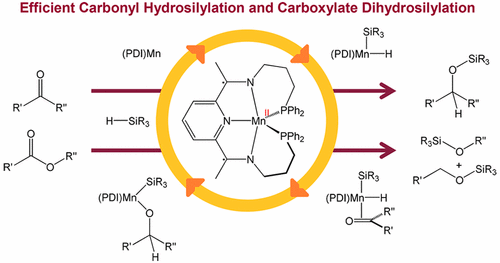当前位置:
X-MOL 学术
›
Acc. Chem. Res.
›
论文详情
Our official English website, www.x-mol.net, welcomes your
feedback! (Note: you will need to create a separate account there.)
The Emergence of Manganese-Based Carbonyl Hydrosilylation Catalysts
Accounts of Chemical Research ( IF 16.4 ) Pub Date : 2017-11-09 00:00:00 , DOI: 10.1021/acs.accounts.7b00422 Ryan J. Trovitch 1
Accounts of Chemical Research ( IF 16.4 ) Pub Date : 2017-11-09 00:00:00 , DOI: 10.1021/acs.accounts.7b00422 Ryan J. Trovitch 1
Affiliation

|
In recent years, interest in homogeneous manganese catalyst development has intensified because of the earth-abundant and nontoxic nature of this metal. Although compounds of Mn have largely been utilized for epoxidation reactions, recent efforts have revealed that Mn catalysts can mediate a broad range of reductive transformations. Low-valent Mn compounds have proven to be particularly effective for the hydrosilylation of carbonyl- and carboxylate-containing substrates, and this Account aims to highlight my research group’s contributions to this field. In our initial 2014 communication, we reported that the bis(imino)pyridine-supported compound (Ph2PPrPDI)Mn mediates ketone hydrosilylation with exceptional activity under solvent-free conditions. Silanes including Ph2SiH2, (EtO)3SiH, (EtO)2MeSiH, and (EtO)Me2SiH were found to partially reduce cyclohexanone in the presence of (Ph2PPrPDI)Mn, while turnover frequencies of up to 1280 min–1 were observed using PhSiH3. This led us to evaluate the hydrosilylation of 11 additional ketones and allowed for the atom-efficient preparation of tertiary and quaternary silanes. At that time, it was also discovered that (Ph2PPrPDI)Mn catalyzes the dihydrosilylation of esters (by way of acyl C–O bond hydrosilylation) to yield a mixture of silyl ethers with modest activity. Earlier this year, the scope of these transformations was extended to aldehydes and formates, and the observed hydrosilylation activities are among the highest obtained for any transition-metal catalyst. The effectiveness of three related catalysts has also been evaluated: (Ph2PPrPDI)MnH, (PyEtPDEA)Mn, and [(Ph2PEtPDI)Mn]2. To our surprise, (Ph2PPrPDI)MnH was found to exhibit higher carboxylate dihydrosilylation activity than (Ph2PPrPDI)Mn, while (PyEtPDEA)Mn demonstrated remarkable carbonyl hydrosilylation activity considering that it lacks a redox-active supporting ligand. The evaluation of [(Ph2PEtPDI)Mn]2 revealed competitive aldehyde hydrosilylation and formate dihydrosilylation turnover frequencies; however, this catalyst is significantly inhibited by pyridine and alkene donor groups. In our efforts to fully understand how (Ph2PPrPDI)Mn operates, a thorough electronic structure evaluation was conducted, and the ground-state doublet calculated for this compound was found to exhibit nonclassical features consistent with a low-spin Mn(II) center supported by a singlet PDI dianion and an intermediate-spin Mn(II) configuration featuring antiferromagnetic coupling to PDI diradical dianion. A comprehensive mechanistic investigation of (Ph2PPrPDI)Mn- and (Ph2PPrPDI)MnH-mediated hydrosilylation has revealed two operable pathways, a modified Ojima pathway that is more active for carbonyl hydrosilylation and an insertion pathway that is more effective for carboxylate reduction. Although these efforts represent a small fraction of the recent advances made in Mn catalysis, this work has proven to be influential for the development of Mn-based reduction catalysts and is likely to inform future efforts to develop Mn catalysts that can be used to prepare silicones.
中文翻译:

锰基羰基氢化硅烷化催化剂的出现
近年来,由于该金属在地球上丰富且无毒,因此人们对均相锰催化剂的开发兴趣增强了。尽管Mn的化合物已被广泛用于环氧化反应,但最近的努力表明,Mn催化剂可介导广泛的还原转化。事实证明,低价Mn化合物对含羰基和羧酸盐的底物进行氢化硅烷化特别有效,该报告旨在强调我的研究小组在该领域的贡献。在2014年的首次交流中,我们报道了双(亚氨基)吡啶负载的化合物(Ph2PPr PDI)Mn在无溶剂条件下介导的酮硅氢加成反应具有出色的活性。硅烷,包括Ph 2 SiH 2,(EtO)3 SiH,(EtO)2 MeSiH和(EtO)Me 2 SiH被发现在(Ph2PPr PDI)Mn存在下部分还原环己酮,而使用PhSiH观察到的翻转频率高达1280 min –1 3。这使我们评估了另外11种酮的氢化硅烷化作用,并允许以原子效率方式制备叔硅烷和季硅烷。当时,也有人发现(Ph2PPrPDI)Mn催化酯的二氢硅烷化(通过酰基C–O键加氢硅烷化),以产生具有适度活性的甲硅烷基醚的混合物。今年早些时候,这些转化的范围扩大到了醛和甲酸酯,而且观察到的氢化硅烷化活性是所有过渡金属催化剂中最高的。还评估了三种相关催化剂的有效性:(Ph2PPr PDI)MnH,(PyEt PDEA)Mn和[(Ph2PEt PDI)Mn] 2。令我们惊讶的是,发现(Ph2PPr PDI)MnH比(Ph2PPr PDI)Mn具有更高的羧酸二氢硅烷化活性,而(PyEt考虑到它缺乏氧化还原活性的支持配体,PDEA)Mn具有显着的羰基氢化硅烷化活性。对[(Ph2PEt PDI)Mn] 2的评估显示出竞争的醛加氢硅烷化和甲酸二氢硅烷化周转频率;然而,该催化剂被吡啶和烯烃供体基团显着抑制。在我们充分了解如何(Ph2PPrPDI)Mn起作用,进行了彻底的电子结构评估,发现该化合物计算出的基态双峰具有非经典特征,与单峰PDI二价阴离子和一个中间的PDI双阴离子支撑的低旋转Mn(II)中心一致。自旋Mn(II)构型具有反铁磁耦合至PDI双自由基二价阴离子的特性。(Ph2PPr PDI)Mn-和(Ph2PPrPDI)MnH介导的氢化硅烷化反应揭示了两个可操作的途径,一个修饰的Ojima途径对羰基氢化硅烷化作用更强,一个插入途径对羧酸盐还原作用更有效。尽管这些努力仅是Mn催化最新进展的一小部分,但已证明这项工作对Mn基还原催化剂的开发具有影响力,并且可能会为开发可用于制备有机硅的Mn催化剂的未来工作提供信息。
更新日期:2017-11-09
中文翻译:

锰基羰基氢化硅烷化催化剂的出现
近年来,由于该金属在地球上丰富且无毒,因此人们对均相锰催化剂的开发兴趣增强了。尽管Mn的化合物已被广泛用于环氧化反应,但最近的努力表明,Mn催化剂可介导广泛的还原转化。事实证明,低价Mn化合物对含羰基和羧酸盐的底物进行氢化硅烷化特别有效,该报告旨在强调我的研究小组在该领域的贡献。在2014年的首次交流中,我们报道了双(亚氨基)吡啶负载的化合物(Ph2PPr PDI)Mn在无溶剂条件下介导的酮硅氢加成反应具有出色的活性。硅烷,包括Ph 2 SiH 2,(EtO)3 SiH,(EtO)2 MeSiH和(EtO)Me 2 SiH被发现在(Ph2PPr PDI)Mn存在下部分还原环己酮,而使用PhSiH观察到的翻转频率高达1280 min –1 3。这使我们评估了另外11种酮的氢化硅烷化作用,并允许以原子效率方式制备叔硅烷和季硅烷。当时,也有人发现(Ph2PPrPDI)Mn催化酯的二氢硅烷化(通过酰基C–O键加氢硅烷化),以产生具有适度活性的甲硅烷基醚的混合物。今年早些时候,这些转化的范围扩大到了醛和甲酸酯,而且观察到的氢化硅烷化活性是所有过渡金属催化剂中最高的。还评估了三种相关催化剂的有效性:(Ph2PPr PDI)MnH,(PyEt PDEA)Mn和[(Ph2PEt PDI)Mn] 2。令我们惊讶的是,发现(Ph2PPr PDI)MnH比(Ph2PPr PDI)Mn具有更高的羧酸二氢硅烷化活性,而(PyEt考虑到它缺乏氧化还原活性的支持配体,PDEA)Mn具有显着的羰基氢化硅烷化活性。对[(Ph2PEt PDI)Mn] 2的评估显示出竞争的醛加氢硅烷化和甲酸二氢硅烷化周转频率;然而,该催化剂被吡啶和烯烃供体基团显着抑制。在我们充分了解如何(Ph2PPrPDI)Mn起作用,进行了彻底的电子结构评估,发现该化合物计算出的基态双峰具有非经典特征,与单峰PDI二价阴离子和一个中间的PDI双阴离子支撑的低旋转Mn(II)中心一致。自旋Mn(II)构型具有反铁磁耦合至PDI双自由基二价阴离子的特性。(Ph2PPr PDI)Mn-和(Ph2PPrPDI)MnH介导的氢化硅烷化反应揭示了两个可操作的途径,一个修饰的Ojima途径对羰基氢化硅烷化作用更强,一个插入途径对羧酸盐还原作用更有效。尽管这些努力仅是Mn催化最新进展的一小部分,但已证明这项工作对Mn基还原催化剂的开发具有影响力,并且可能会为开发可用于制备有机硅的Mn催化剂的未来工作提供信息。











































 京公网安备 11010802027423号
京公网安备 11010802027423号